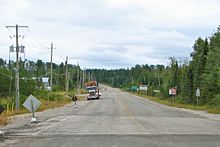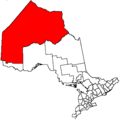District in Ontario, Canada
| Kenora District | |
|---|---|
| District | |
 Location of Kenora District in Ontario Location of Kenora District in Ontario | |
| Coordinates: 54°N 89°W / 54°N 89°W / 54; -89 | |
| Country | |
| Province | |
| Region | Northwestern Ontario |
| Created | 1907 |
| Government | |
| • MPs | Eric Melillo (CPC), Charlie Angus (NDP) |
| • MPPs | Greg Rickford (PC), Guy Bourgouin (NDP), Sol Mamakwa (NDP) |
| Area | |
| • Land | 395,432.07 km (152,677.18 sq mi) |
| Highest elevation | 505 m (1,657 ft) |
| Lowest elevation | 0 m (0 ft) |
| Population | |
| • Total | 66,000 |
| • Density | 0.2/km (0.5/sq mi) |
| Time zones | |
| West of 90° west | UTC-6 (Central (CST)) |
| • Summer (DST) | UTC-5 (Central Daylight (CDT)) |
| East of 90° west | UTC-5 (Eastern (EST)) |
| • Summer (DST) | UTC-4 (Eastern Daylight (EDT)) |
| Pickle Lake/ Mishkeegogamang | UTC-5 (Eastern (EST)) |
| Postal Code FSA | P0V, P0X, P0Y, P8N, P8T, P9N |
| Area code | 807 |
| Largest communities | Kenora (15,177) Dryden (8,195) Sioux Lookout (5,183) |
Kenora District is a district and census division in Northwestern Ontario, Canada. The district seat is the City of Kenora.
It is geographically the largest division in Ontario: at 407,213.01 square kilometres (157,225.82 sq mi), it covers 38 percent of the province's area, making it larger than Newfoundland and Labrador, and slightly smaller than Sweden or roughly the land size of California. Kenora District also has the lowest population density of any of Ontario's census divisions (it ranks 37th out of 50 by total population).
The district was created in 1907 from parts of Rainy River District. The northern part (north of the Albany River) only became part of Ontario in 1912 (transferred from the Northwest Territories). The separate Patricia District upon transfer, it was in 1937 annexed to Kenora District and known sometimes as the Patricia Portion.
Politics
As with the other districts of Northern Ontario, the Kenora District does not have an organized government like those of counties or regional municipalities in Southern Ontario. All government services in the district are instead provided by the local municipalities, by local services boards in some unincorporated communities, or directly by the provincial government.
Geography
The climate is very harsh because of the influence of the cold waters of Hudson and James Bays: most of the region is taiga characterized by discontinuous permafrost, but on the extreme northern coast there are – remarkably for a latitude of only 54°N – patches of true Arctic tundra and continuous permafrost. This is the southernmost point in the Northern Hemisphere reached by the circumpolar line of continuous permafrost on any continent.
Kenora District is geographically extensive enough to share borders with both the contiguous United States (the boundary between it and the Northwest Angle is located in the Lake of the Woods) and the Canadian Arctic waters (Hudson Bay), the only district in Canada to do so.
The District contains the Sturgeon Lake Caldera, which is one of the world's best preserved Neoarchean caldera complexes and is some 2.7 billion years old.
Subdivisions
Cities:

Towns:
Townships:
Unorganized areas:
- Kenora, Unorganized (including the local services boards of Greater Oxdrift, Melgund, Minaki, Redditt, Round Lake, and Wabigoon)
First Nations reserves
- Attawapiskat
- Bearskin Lake
- Cat Lake
- Deer Lake
- Eabametoong
- Eagle Lake 27
- English River 21
- Fort Albany 67 (part)
- Fort Severn 89
- Islington 29
- Kasabonika
- Keewaywin
- Kenora 38B
- Kingfisher Lake
- Kitchenuhmaykoosib Inninuwug
- Lac Seul
- Lake of the Woods 31G
- Lake of the Woods 37
- Marten Falls
- Mishkeegogamang
- Muskrat Dam Lake
- Neskantaga
- Northwest Angle 33
- North Spirit Lake
- Pikangikum
- Poplar Hill
- Rat Portage 38A
- Sabaskong Bay 35D
- Sachigo Lake
- Sandy Lake
- Shoal Lake 39A (part)
- Shoal Lake 40 (part)
- Shoal Lake 34B2
- The Dalles 38C
- Wabauskang 21
- Wabigoon Lake
- Wapekeka
- Wawakapewin
- Weagamow Lake 87
- Whitefish Bay 32A
- Whitefish Bay 33A
- Whitefish Bay 34A
- Wunnumin Lake
Patricia Portion

The Patricia Portion is the part of the Kenora District lying north of the Albany River, which was transferred from the Northwest Territories to Ontario on May 15, 1912, in The Ontario Boundaries Extension Act. This area was originally a separate division, Patricia District, but became part of Kenora District in 1937.
With the exception of a few communities along the northernmost ends of Highway 599 and the Highway 105/Highway 125 corridor, the Patricia Portion consists almost entirely of remote First Nations communities that are only accessible by float plane or winter road. Accordingly, the term "Patricia Portion" is still sometimes used to distinguish the region from the relatively more populated and road-accessible southern portion.
Demographics
As a census division in the 2021 Census of Population conducted by Statistics Canada, the Kenora District had a population of 66,000 living in 24,818 of its 32,914 total private dwellings, a change of 0.7% from its 2016 population of 65,533. With a land area of 395,432.07 km (152,677.18 sq mi), it had a population density of 0.2/km (0.4/sq mi) in 2021.
Canada census – Kenora District community profile| 2021 | 2016 | 2011 | |
|---|---|---|---|
| Population | 66,000 (+0.7% from 2016) | 65,533 (+13.8% from 2011) | 57,607 (−10.6% from 2006) |
| Land area | 395,432.07 km (152,677.18 sq mi) | 407,268.65 km (157,247.30 sq mi) | 407,213.01 km (157,225.82 sq mi) |
| Population density | 0.2/km (0.52/sq mi) | 0.2/km (0.52/sq mi) | 0.1/km (0.26/sq mi) |
| Median age | 37.6 (M: 36.8, F: 38.4) | 36.5 (M: 35.8, F: 37.1) | |
| Private dwellings | 32,914 (total) 24,818 (occupied) | 31,191 (total) 23,931 (occupied) | 29,606 (total) |
| Median household income | $78,500 | $66,198 |
References: 2021 2016 2011
|
|
| |||||||||||||||||||||||||||||||||||||||||||||||||||||||||||||||
| Excludes census data for one or more incompletely enumerated Indian reserves. Population counts are not adjusted for boundary changes. Source: Statistics Canada | |||||||||||||||||||||||||||||||||||||||||||||||||||||||||||||||||
Economy
Most of the population is concentrated in the district's extreme south where some agriculture is possible: the main crop is barley. Traditional native activities such as hunting and fishing dominate the north of the district outside of mining settlements.
Mining
The area near Lake Minnehaha saw a gold rush between 1902 and 1909. The settlement of Gold Rock served 14 area mines, which included the Big Master, Laurentian, Detola and Elora. According to Barnes, "Approximately 180,000 ounces of gold was won from 27 mines in the Kenora district from 1880 to 1976," with "over 331 known gold occurrences." The more successful mines included the Bully Boy, Cameron Island, Champion, Combined, Cornucopia, Gold Hill, Golden Horn, Kenricia, Mikado, Oliver, Olympia, Ophyr, Regina, Scramble, Severn, Stella, Sultana, Treasure and Wendigo.
Mining is currently extremely extensive in northern Kenora District, which contains some of the world's largest and highest-grade reserves of uranium and some of the world's major producers of nickel. A major mining exploration project is currently underway in the Ring of Fire region, centred on the district's isolated McFaulds Lake.
Transportation

Permanent roads (Highway 599) only reach about halfway to the northernmost point of Kenora district, with the provincial highway network ending at Pickle Lake. Some more northerly communities connect seasonally through an ice/winter road network to the Northern Ontario Resource Trail.
Year-round air and summertime river transport are the only means of reaching the most remote parts of the district.
The major railroad lines between Toronto and British Columbia pass through the south of the district. The district is served by Via Rail's Canadian at Rice Lake, Copelands Landing, Malachi, Ottermere, Minaki, Redditt, Farlane station, Canyon, Red Lake Road, Richan, and Sioux Lookout stations.
| Current services at Rice Lake station | ||||
|---|---|---|---|---|
| Preceding station | Following station | |||
| Winnitobatoward Vancouver | The Canadian | Copelands Landingtoward Toronto | ||
| Former services at Rice Lake station | ||||
| Preceding station | Canadian National Railway | Following station | ||
| Winnitobatoward Vancouver | Main Line | Malachitoward Montreal | ||
| Current services at Copelands Landing | ||||
| Preceding station | Following station | |||
| Rice Laketoward Vancouver | The Canadian | Malachitoward Toronto | ||
| Former services at Copelands Landing | ||||
| Preceding station | Canadian National Railway | Following station | ||
| Rice Laketoward Vancouver | Main Line | Malachitoward Montreal | ||
| Current services at Malachi station | ||||
| Preceding station | Following station | |||
| Copelands Landingtoward Vancouver | The Canadian | Ottermeretoward Toronto | ||
| Former services at Malachi station | ||||
| Preceding station | Canadian National Railway | Following station | ||
| Copelands Landingtoward Vancouver | Main Line | Ottermeretoward Montreal | ||
See also
- List of census divisions of Ontario
- List of townships in Ontario
- List of secondary schools in Ontario#Kenora District
References
- ^ "Kenora, District (DIS) Census Profile, 2021 Census of Population". www12.statcan.gc.ca. Government of Canada - Statistics Canada. Retrieved December 6, 2024.
- Compilation of Northwestern Ontario's 2006 census data
- Highest elevation from MapArt 2003 Edition Ontario Provincial Map – G4 south of Willard Lake. Hudson Bay is at MSL
- ^ The Ontario Boundaries Extension Act, S.C. 1912 (CA), 2 Geo. V, c. 40.
- ^ Patricia Act, RSO 1937, c 5 (retrieved March 26, 2016).
- Caldera Volcanoes Retrieved on July 20, 2007
- "2021 Community Profiles". 2021 Canadian census. Statistics Canada. February 4, 2022. Retrieved October 19, 2023.
- "2016 Community Profiles". 2016 Canadian census. Statistics Canada. August 12, 2021. Retrieved December 6, 2024.
- "2011 Community Profiles". 2011 Canadian census. Statistics Canada. March 21, 2019. Retrieved March 20, 2012.
- "1971 Census of Canada - Population Census Subdivisions (Historical)". Catalogue 92-702 Vol I, part 1 (Bulletin 1.1-2). Statistics Canada: 76, 139. July 1973.
- Barnes, Michael (1995). Gold in Ontario. Erin: The Boston Mills Press. pp. 23–26. ISBN 155046146X.
- "Rice Lake train station | VIA Rail". Via Rail. Retrieved March 29, 2024.
- "Copelands Landing train station | VIA Rail". www.viarail.ca. Via Rail. Retrieved March 29, 2024.
External links
- [REDACTED] Media related to Kenora District at Wikimedia Commons
| Places adjacent to Kenora District | ||||||||||||||||
|---|---|---|---|---|---|---|---|---|---|---|---|---|---|---|---|---|
| ||||||||||||||||
| Subdivisions of Ontario | |
|---|---|
| Counties | |
| Districts | |
| Regional municipalities | |
| Single-tier municipalities | |
| Separated municipalities | |
| Regions | |
